The North America Genotyping Market would witness market growth of 14.2% CAGR during the forecast period (2022-2028).
Genotyping with single-nucleotide polymorphism identifiers is currently frequently employed in small grain cereal genetic research and breeding. An almost limitless supply of SNP markers has been available due to various technologies such as the scanning of specific portions of the genome, such as transcribed sequences, or the resequencing of variety and lines.
Many samples are now routinely genotyped, especially within the context of genomic selection (GS), employing two distinct approaches such as genotyping-by-sequencing (GBS) and array-based genotyping with predetermined marker sets. Array-based genotyping in tiny grain breeding is evolving from pricey big arrays to smaller, freshly created second-generation arrays. Markers for specific phenotypes, along with high-quality polymorphic markers that are equally dispersed across the chromosomes and have little ascertainment bias, are included in such arrays.
Depending on a log-likelihood proportion calculation, genotype clusters are additionally categorized as non, a medium alert, or high alert. When compared to the concentration of the genotype across the country, alert levels reflect the degree of geographic intensity of cases in the same county or township area. American Indian or Alaska Native people and Native Hawaiian or Other Pacific Islander people continue to have the highest percentages of genotype-clustered cases.
The biggest number of clustered instances were seen among Hispanic or Latino people and non-Hispanic Black or African American people. The number of county-based clusters decreased by 5.3 percent from 1,351 in previous year's cases reported nationally from 2017 to 2019 to 1,280 in 2018–2020.
Universal TB genotyping entails sending at least one isolate to genotyping laboratories for every civilization TB patient in the country. The best understanding of the epidemiology of tuberculosis transmission inside a single TB program's jurisdiction, as well as across the country, would come from universal TB genotyping.
The US market dominated the North America Genotyping Market by Country in 2021, and would continue to be a dominant market till 2028; thereby, achieving a market value of $8,381.6 million by 2028. The Canada market is estimated to grow at a CAGR of 16.8% during (2022 - 2028). Additionally, The Mexico market would showcase a CAGR of 15.8% during (2022 - 2028).
Based on Product, the market is segmented into Reagents & Kits, Instruments, and Software & Services. Based on Application, the market is segmented into Diagnostics & Personalized Medicine, Agricultural Biotechnology, Pharmacogenomics, Animal Genetics, and Others. Based on End Use, the market is segmented into Diagnostics & Research Laboratories, Pharmaceutical & Biopharmaceutical Companies, Academic Institutes, and Others. Based on Technology, the market is segmented into PCR, Sequencing, Capillary Electrophoresis, Microarray, Mass Spectrometry, and Others. Based on countries, the market is segmented into U.S., Mexico, Canada, and Rest of North America.
Free Valuable Insights: The Global Genotyping Market is Estimated to reach $30.9 Billion by 2028, at a CAGR of 14.7%
The market research report covers the analysis of key stake holders of the market. Key companies profiled in the report include F. Hoffmann-La Roche Ltd., Danaher Corporation, Agilent Technologies, Inc., Thermo Fisher Scientific, Inc., Qiagen N.V., Illumina, Inc., Bio-Rad Laboratories, Inc., Eurofins Scientific Group, and Fluidigm Corporation.
By Product
By Application
By End Use
By Technology
By Country
Our team of dedicated experts can provide you with attractive expansion opportunities for your business.

